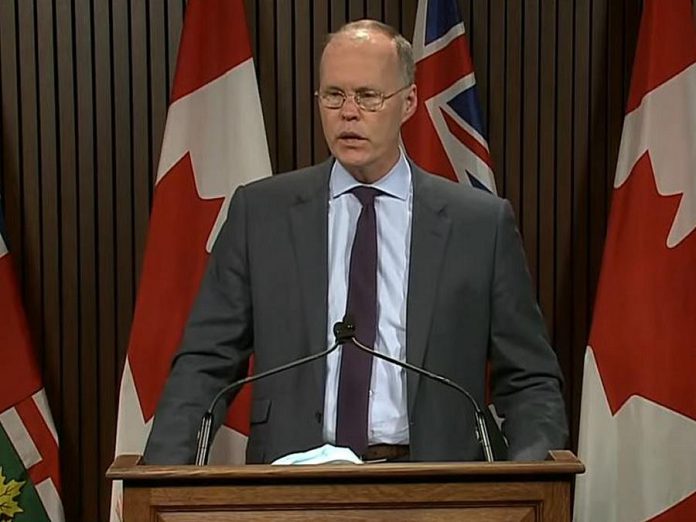
With Ontario’s top public health officials now projecting up to 7,000 daily COVID-19 cases in Ontario by the end of December, the Ontario government is lowering the thresholds of its colour-coded system for public health unit regions and moving additional health units into more restrictive levels.
Premier Doug Ford made the announcement on Friday afternoon (November 13) at a media conference along with health minister Christine Elliott and Ontario’s chief medical officer of health Dr. David Williams.
“Yesterday, our top doctors and health experts provided us with updated modelling, and what we saw was alarming,” Ford said. “If we don’t take action, if we don’t change course in a big way, Ontario’s on track for 6,500 new cases per day.”
“That’s 6,500 more people who will catch this awful virus each and every day, and based on current projections, intensive care units could be overwhelmed in six weeks. The impact on our hospitals would be absolutely devastating. As Premier, I can’t accept that and I won’t accept that.”
For each of the five levels in its colour-coded system, the government will be lowering the thresholds that determine when a public health unit is moved into a more restrictive level. Since it released the colour-coded system on November 3rd, the government has been criticized that the thresholds were set at too high a level.
With the November 13th announcement, the thresholds will be lowered for weekly incidence rates, positivity rate, effective reproductive number (Rt), outbreak trends, and the level of community transmission.
As a result, the public health units for Toronto, Hamilton, Halton, and York will move into the Red-Control level.
Brant County, Durham, Eastern Ontario Health Unit, Niagara, Wellington-Dufferin-Guelph, and Waterloo will move into the Orange-Restrict level.
Huron Perth, Middlesex-London, Sudbury, Southwestern Public Health, and Windsor-Essex will move into the Yellow-Protect level.
The changes take effect at 12:01 a.m. on Monday (November 16), except for Toronto, which will move into the Red-Control level at 12:01 a.m. on Saturday (November 14).
The remaining health units in Ontario, including the three health units in the greater Kawarthas region (Peterborough Public Health, Hastings and Prince Edward Counties Public Health, and Haliburton, Kawartha, Pine Ridge District Health Unit), remain in the Green-Prevent level.

The government’s decision to modify the framework comes one day after updated modelling projections presented at a media briefing on Thursday afternoon (November 12) by Dr. David Williams, Ontario’s chief medical officer of health, along with Adalsteinn Brown, dean of the Dalla Lana School of Public Health at the University of Toronto, and Dr. Dirk Huyer, Ontario’s chief coronor and coordinator of the province’s COVID-19 response.
In a slide presentation during the media briefing, Brown compared Ontario’s COVID-19 situation to that of European countries.
When the data for the presentation was pulled together, Brown said, Ontario’s seven-day daily growth rate was at three per cent, already surpassing the growth rate in Germany that resulted in a four-week partial lockdown in that country on November 2nd. By the end of December, Ontario would exceed the growth rate in France — already in lockdown — with between 3,000 and 4,000 daily cases by the end of December.
“When we built these models a few days ago, three per cent was a reasonable way of capturing the average seven-day growth in total number of cases,” Brown explained. “Seven-day growth is actually probably closer to about four per cent right now, so it’s climbing up.”
At a five per cent daily growth rate, Ontario would see between 6,000 and 7,000 daily cases by the end of December — exceeding the growth rate in Germany, France, and the UK, and approaching the growth rate in the Netherlands.
Brown emphasized that even small changes in the rate of growth result in large changes in the number of cases, and that Ontario’s growth rate could actually be higher than five per cent — resulting in even more than 7,000 daily cases.
“The three-day rate of growth a few days was about five per cent — it’s now six per cent,” Brown said. “So if the last few days is a reasonable point of extrapolation, it’s fair to say that the five per cent is a current, or maybe slightly optimistic, scenario.”
In addition to the growth rate, Brown said the number of cases in long-term care homes continues to accelerate, with a substantial increase in cumulative mortality — with 71 deaths in the past seven days.
“As case rates climb, we expect mortality to climb as well,” Brown said.
PDF: Update on COVID-19 Projections in Ontario – November 12, 2020
Update on COVID-19 Projections in Ontario - November 12, 2020
When it comes to hospitalizations, there has been a 61 per cent increase over the past three weeks, and a 167 per cent increase over the past six weeks.
“It is still a relatively low number of hospitalization compared to the total number of hospital beds in the province,” Brown noted. “But it’s important to keep in mind as well that our hospitals run very close to capacity at all times.”
Brown said there is some good news — the average length of stay in hospital for patients with COVID-19 has declined, especially for patients receiving ventilation in intensive care units (ICUs).
However, Brown added that the ICU occupancy in any of the modelling scenarios will exceed 150 beds within two or three weeks — the threshold for reducing access to care for non-COVID patients.
“Before the end of December though — within about six weeks — almost all of our scenarios take us well over 200 ICU beds being occupied, and in the worst-case scenario we get up close to 450 ICU beds occupied with COVID-19 patients.”
Brown said this would place significant limitations on the health system’s ability to react to additional patient needs and access to care.
After Brown’s presentation, Dr. Dirk Huyer provided information on outbreaks and community transmission during the second wave of COVID-19 in Ontario.
He said there were 29 new outbreaks reported on November 12, including 18 outbreaks in the vulnerable sector and the school sector, six in the public-facing sector including retail and other settings where the public attend, and five in workplaces.
There has been a 57 per cent increase in the number of outbreaks over the past week, at 168, with 632 outbreaks over the past month. Outbreaks have been reported in 22 of Ontario’s 34 public health units, expanding beyond the vulnerable sector and schools.
“It’s important to remember that, while outbreaks are something that’s identifiable, it’s 10 per cent of the cases,” Huyer said.
Huyer added that, while outbreaks are not representative of community transmission, they provide a proxy of community spread in social settings.
Data provided by the Ontario COVID-19 Science Advisory Table shows that 40 to 60 per cent of cases are due to community transmission, but the source of the infection is unknown. However, evidence shows social gatherings in public and private settings must be responsible, including settings as indoor dining at restaurants.
“The increased number of cases and the increased number of contacts make it very challenging to be able to identify the source,” Huyer said.
“Because trying to understand the complexities of case management, with many people that you intersect with, makes it very difficult to sort backwards and try to figure out where the transmission actually occurred, and then also challenging to be able to contact and connect with all of those who might have been in contact in a high-risk situation, which is important to stop the spread.”
Huyer added that many of the outbreaks have been associated with specific social gatherings, including Halloween parties, weddings, and places of worship, where people get infected and then spread the virus in other settings.
In his concluding remarks, Dr. Williams said that, after eight months of the pandemic, Ontarians are tired of the restrictions and want to get together with others, but social gatherings are feeding the spread of the virus.
“This is a critical time for our province. We know how difficult these past few months have been for everyone — Ontario’s communities, businesses, and families. But the challenge is we need to get these numbers down, to protect the health and safety of Ontarians and to protect our health care system from being overwhelmed, especially as we enter respiratory virus season and flu season.”
Williams said “time is of the essence” when it comes to taking action to address the growth rate.
In response to a reporter’s question, Brown said the growth rate would continue as projected if existing restrictions were not modified.
When another reporter asked if additional restrictions should be implemented in the province’s hotspots, Brown’s answer was straightforwards.
“If the goal is to reduce the number of cases, and the goal is to reduce the impact on the health system, then yes.”


























